
Final Fantasy Mystic Quest, released as Mystic Quest Legend in PAL regions and as Final Fantasy USA: Mystic Quest in Japan, is a role-playing video game for the Super Nintendo Entertainment System. The game was released as a spin-off to Square's Final Fantasy series of video games. Final Fantasy Mystic Quest was first released in North America in 1992 and marketed as a "simplified role-playing game... designed for the entry-level player" in an attempt to broaden the genre's appeal. The game's presentation and battle system is broadly similar to that of the main series, but it differs in its inclusion of action-adventure game elements. Final Fantasy Mystic Quest was the first Final Fantasy game to be released in Europe.

Age of Wonders is a 1999 turn-based strategy game co-developed by Triumph Studios and Epic MegaGames, and published by Gathering of Developers.

HeroQuest, sometimes written as Hero Quest, is an adventure board game created by Milton Bradley in conjunction with the British company Games Workshop. The game was loosely based around archetypes of fantasy role-playing games: the game itself was actually a game system, allowing the gamemaster to create dungeons of their own design using the provided game board, tiles, furnishings and figures. The game manual describes Morcar/Zargon as a former apprentice of Mentor, and the parchment text is read aloud from Mentor's perspective. Several expansions were released, each adding new tiles, traps, artifacts, and monsters to the core system.

Paladin's Quest, originally released as Lennus: Kodai Kikai no Kioku in Japan, is a utopian/dystopian science fantasy role-playing video game developed by Copya System and published in Japan by Asmik Corporation on November 13, 1992, for the Super Nintendo Entertainment System. It was published in North America by Enix in October 1993. It was different from other role-playing games at the time, because when the player casts magic, it takes away HP instead of MP.
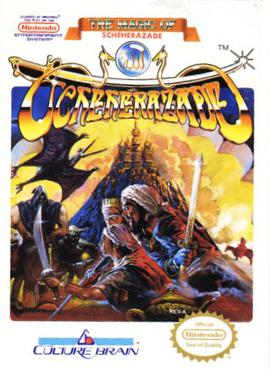
The Magic of Scheherazade is an action-adventure/role-playing video game (RPG) developed and released by Culture Brain for the Nintendo Entertainment System (NES). The game was released in 1987 in Japan and 1990 in North America. The plot is based on Middle Eastern folktales found in One Thousand and One Nights. It involves an amnesic hero traveling through time in an attempt to rescue the princess Scheherazade from the evil wizard Sabaron, who has summoned a horde of demons to bring chaos to the once peaceful land of Arabia. The Magic of Scheherazade is divided into chapters and incorporates elements of both action-adventure and RPG gameplay styles. In each chapter, the player character can freely explore an overworld in a top-down perspective. The player engages hostile enemies with various weapons and spells through both real-time solo action on the overhead map and random, turn-based battles fought alongside befriended allies.
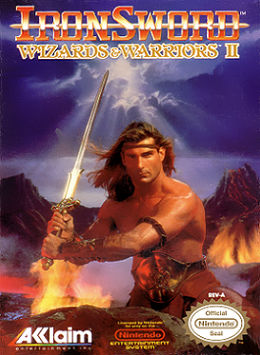
Ironsword: Wizards & Warriors II is a platforming action-adventure video game for the Nintendo Entertainment System (NES) developed by UK-based company Zippo Games, a subsidiary of Rare. The game was published by Acclaim and released in North America in December 1989 and in Europe on March 27, 1991. It is the sequel to Rare's 1987 title Wizards & Warriors. In Ironsword, the player controls the knight warrior Kuros as he ventures in the land of Sindarin. He must defeat the evil wizard Malkil, who has assumed the elemental forms of Earth, Wind, Fire, and Water. Kuros must collect the parts of and assemble the legendary "IronSword" in order to defeat Malkil, who resides at the top of IceFire Mountain.

Arcana is a role-playing video game released for the Super Nintendo Entertainment System by HAL Laboratory in 1992. The game represents all of its characters as cards, but plays like a dungeon-crawling role-playing game rather than a card-based game. In keeping with this metaphor, the death of a character results in a 'torn' card, and the magical properties of some cards are used to explain abilities of the game's characters.
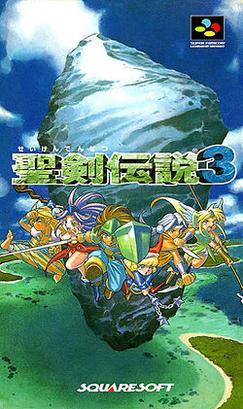
Trials of Mana, also known by its Japanese title Seiken Densetsu 3, is a 1995 action role-playing game developed and published by Square for the Super Famicom. It is the sequel to the 1993 game Secret of Mana, and is the third installment in the Mana series. Set in a high fantasy world, the game follows three heroes as they attempt to claim the legendary Mana Sword and prevent the Benevodons from being unleashed and destroying the world. It features three main plotlines and six different possible main characters, each with their own storylines, and allows two players to play simultaneously. Trials of Mana builds on the gameplay of its predecessor with multiple enhancements, including the use of a time progression system with transitions from day to night and weekday to weekday in game time, and a wide range of character classes to choose from, which provides each character with an exclusive set of skills and status progression.

Magic Carpet is a 3D flying video game developed by Bullfrog Productions and published by Electronic Arts in 1994. Its graphics and gameplay were considered innovative and technically impressive at the time of its release.

King's Quest III: To Heir Is Human is the third installment in the King's Quest series of graphic adventure games developed and released by Sierra On-Line in 1986. The game was originally released for the Apple II and PC DOS, and later ported to several other computer systems. It was the first title game in the series not to feature King Graham as the player character.
The collectible card game Magic: The Gathering published ten base sets from 1993–2007, also referred to as core sets. With the exception of Limited Edition, these sets consisted entirely of reprints. These cards were generally simpler than cards in expansion sets, omitting multicolored cards, and used only the original abilities and keywords of Magic such as Flying and Trample. This simplicity led to many cards from these sets being considered "staples" of deck design. All cards were given a white border to mark them as reprints, with a few exceptions. From Fourth Edition in 1995 onward, a new base set would come out once per two years in the spring or early summer; for tournament play, that set would be legal for two years in the Standard format until the next core set replaced it.
Magic systems in games are the rules, limitations, abilities, and characteristics that define magic in a game.
Disney's Magical Quest is a Disney platform game trilogy released by Capcom. The games star Mickey Mouse and either Minnie Mouse or Donald Duck, who must defeat Pete. The gameplay is similar amongst all games in the series: the player must move as in a typical platform game, defeating enemies either by jumping on them or by grabbing and throwing blocks at them.

Sphinx and the Cursed Mummy is an action-adventure video game inspired by the mythology of Ancient Egypt for GameCube, PlayStation 2 and Xbox. The game was developed by Eurocom and published by THQ. Nordic Games acquired THQ in 2014 and formed THQ Nordic, as a result, a remastered version of the game was released worldwide for Microsoft Windows, macOS and Linux on November 10, 2017. A physical Nintendo Switch version with several enhancements was released on January 29, 2019.
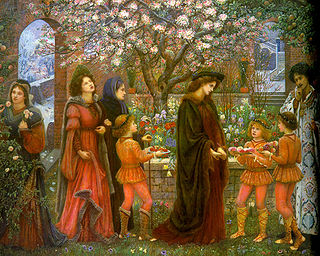
A magician, also known as an enchanter/enchantress, mage, magic-user, archmage,sorcerer/sorceress, spell-caster, warlock, witch, or wizard, is someone who uses or practices magic derived from supernatural, occult, or arcane sources. Magicians are common figures in works of fantasy, such as fantasy literature and role-playing games, and enjoy a rich history in mythology, legends, fiction, and folklore.

Magic: The Gathering is a video game published by MicroProse in April 1997 based on the collectible card game Magic: The Gathering. It is often referred to as Shandalar after the plane of Shandalar, where the game takes place. The player must travel the land and fight random enemies to gain cards, and defeat five wizards representing the five colors. The player must prevent one color from gaining too much power, and defeat the planeswalker Arzakon, who has a deck of all five colors. Adventure and role-playing elements are present, including inventory, gold, towns, dungeons, random battles, and character progression in the form of new abilities and a higher life point total. An oversized version of Aswan Jaguar was included in the game box.
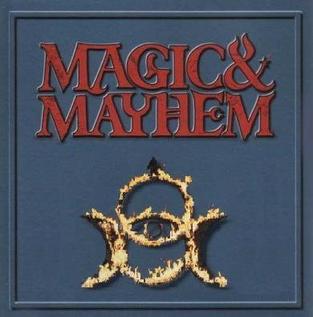
Magic & Mayhem, known in Europe as Mana, is a fantasy/mythology-themed real-time strategy game designed by Julian Gollop and developed by Mythos Games. It was published by Virgin Interactive Entertainment in late 1998, and by Bethesda soon after in 1999. Although the game received generally positive criticisms, it met a quiet public reception.
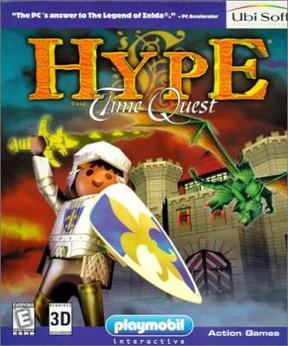
Hype: The Time Quest is an adventure video game developed by Ubi Soft Montreal and published by Ubi Soft and was released under the Playmobil Interactive series of products. The game, released in the year 1999 along with Alex Builds His Farm (1999), is based on the medieval castle toy series from Playmobil. The U.S. version of the Game Boy Color version was supposed to be released in June 2000, but was delayed for over a year. The game revolves around Hype, a 22-year-old knight in the service of King Taskan IV, following a quest through time to return to his own time in order to save the kingdom from the evil black knight Barnak. Hype's adventures therefore take place in the same kingdom throughout four different periods of its history. The game was directed by Alain Tascan and featured thirty-two different voice actors, as well as original music by Robbi Finkel.
The Rules of Magic: The Gathering govern the play of the card game Magic: The Gathering. The original rules were developed by the game's creator, Richard Garfield, and accompanied the first version of the game in 1993. The rules of Magic have been changed frequently over the years by the manufacturer, Wizards of the Coast, mostly in minor ways. However, major rules overhauls have also been done a few times.

Puzzle Quest is a series of Match 3 and role-playing video game hybrids published by Infinity Plus Two. It was first begun in 2007 with the release of Puzzle Quest: Challenge of the Warlords, a spin-off of the Warlords series of turn-based strategy games, and since expanded to other licensed content models. Its latest game, Puzzle Quest: The Legend Returns, was released in 2019.














